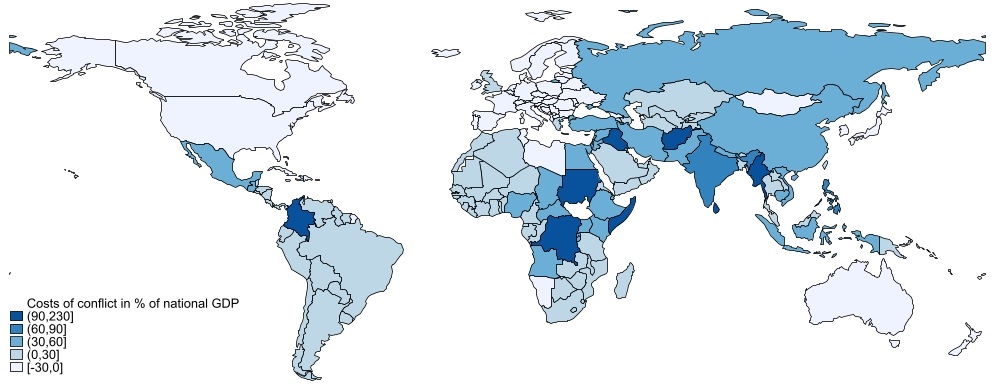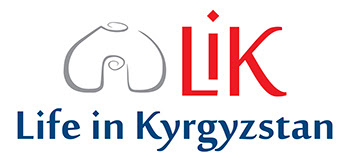The order of magnitude of the economic burden of war is comparable to that of other ‘global public bads’, such as climate change, land degradation, alcohol consumption or malaria.

Figure 1. Distribution and structure of the burden of violent conflict in 2014
Disaggregation of the relative burden of conflict per country worldwide.
In 2014, the world would have been 12% wealthier had violent conflict been absent since 1970. How are the losses distributed? What can be done to mitigate the impact of war on national and global economies? A newly published paper in the Journal for Peace Research written by ISDC’s Tilman Brück and colleagues shows that preventing war is good economics.
The study shows huge global disparities in how the costs of conflict are distributed (see Figure 1). Developing countries were hit hardest by violent conflict, while most high-income countries benefited from their external participation; thereby exaggerating global imbalances. Countries that fight wars far away from home benefit economically from their domestic military spending, while causing damage to foreign territories. By region, Asia would have benefited the most from the absence of violent conflict between 1970 and 2014, while North America would have lost USD 0.9 trillion during that period. For seven countries (including Iraq and Afghanistan), total GDP would have more than doubled in the absence of violent conflict.
Violent conflict has a negative effect on economic output as it disrupts production, prioritises military spending over other, more productive public expenditures, and encourages portfolio substitutions by shifting assets from violent to more peaceful countries. In addition, countries neighbouring those in which violent conflicts occur suffer from increased insecurity and reduced trade through so-called spillover effects.
The authors find that civil (or internal) conflicts continue to significantly influence growth up to four years after the conflict ends. While they do find some evidence of a post-conflict ‘peace dividend’, the net accumulated GDP gap remains negative for most affected economies, especially those emerging from civil conflicts.

Figure 2. Effects of different policy simulations on the global burden of conflict
Estimates for scenarios (1)-(3) represent the difference between the global burden when there is no conflict ever, and the burden in each scenario. Thus, scenario (1) shows the most promising policy option to reduce the global burden of conflict.
The findings suggest that public policy should, first, aim to prevent wars to avoid the costs of conflict in the first place (see path 3 in Figure 2). If wars have taken place, accelerating post-conflict reconstruction can help the affected countries recover the lost output (see path 1 in Figure 2). In practice, many war-affected countries are left to their own devices, living under the growth-reducing shadows of past conflicts.
Using a panel of 190 countries and studying macroeconomic and conflict data from 1970 to 2014 with advanced statistical techniques, the authors estimate the average cost of various dimensions of conflicts on yearly GDP growth. Uniquely, they consider three types of conflict: civil, interstate and non-territorial war (an example of the latter is participation in conflict on foreign soil). A conflict intensity scale from 0 to 10 is used in order to derive the differential impact on economic growth.
Professor Tilman Brück, Director of ISDC and the lead author of the study, comments: “Our study is the most comprehensive and detailed investigation of the economic costs of war. Our analysis shows that the economic benefits of peace are taken for granted all too often. We need to strengthen institutions for peace to achieve prosperity and sustainability for all. Preventing war is good economics. And rebuilding post-war economies is also a good investment.”
The study was prepared by Olaf J. De Groot (Office of the UN Resident Coordinator for Jamaica, Bahamas, Bermuda, Turks and Caicos & Cayman Islands), Carlos Bozzoli (Fundación Bunge y Born), Anousheh Alamir (European Center for Advanced Research in Economics and Statistics, Université libre de Bruxelles) and Tilman Brück (ISDC – International Security and Development Center, Natural Resources Institute, Leibniz Institute of Vegetable and Ornamental Crops, IZA and Households in Conflict Network). The original research underlying the study was funded by the Deutsche Stiftung Friedensforschung.



